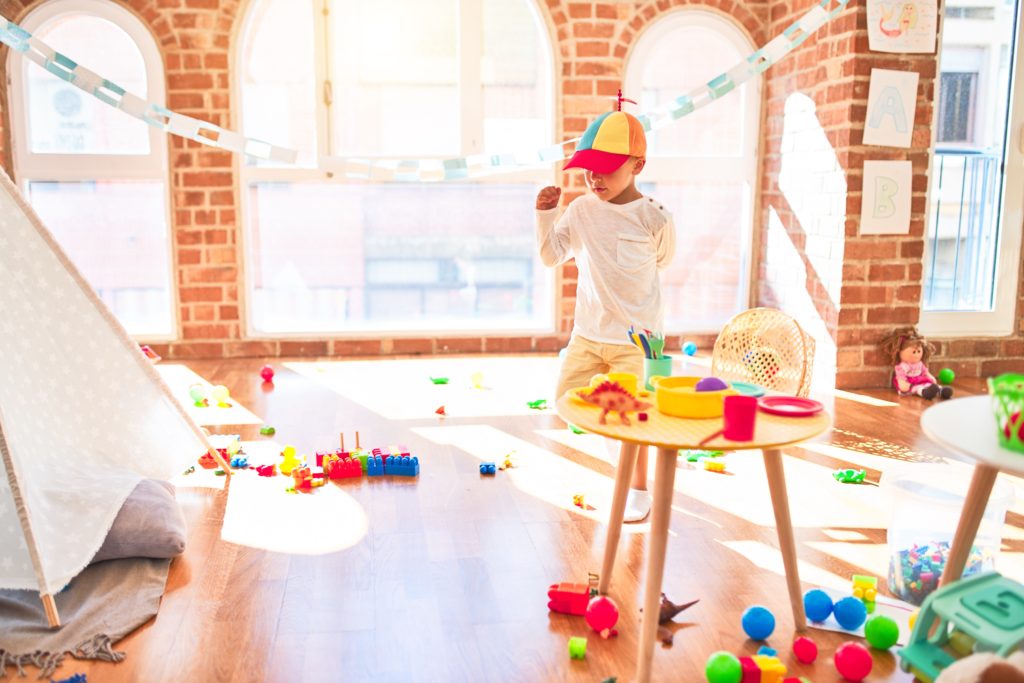
Preschool classroom behavior management can be very challenging. Even after 11 years in the classroom, I find managing behavior one of the hardest parts of my job. For this reason, I spend a lot of time researching and trying new ways to bring peace and harmony to my classes. Above all, I am aware that behavior management will constantly evolve and change throughout the year. However, I have learned that there are a few fundamentals that if followed consistently, will make behavior issues manageable, and almost non-existent.
Effective Preschool Classroom Behavior Management Starts with Connection

The cornerstone of Preschool classroom behavior management is relationships. Procedures and clear expectations from the start are important. However, the most important thing any teacher can do is create connections. For this reason, you should find a way to connect with each student right from the start. A connection can be as simple as letting them know your favorite color is the same as theirs. Some connections can also come from comforting a child who is hurt or sad. Even sharing the identity of your favorite superhero can form a strong bond. If a child knows you are like them or that you care, they will want to please you.
Therefore, the children are more likely to follow the rules and make good choices. Following the rules and making good choices will always equal less behavior management for you!
Find the good in each child in your classroom. Learn something unique about each one, and let them know you remember. Do that, and your job will not only be easier, but it will be a joy.
Preschool Classroom Behavior Management Amidst Chaos

Let me tell you what happened in my classroom just 2 weeks ago. Picture this, if you can. A new student came into our class after school had been in session for a month and a half. Not only did this new student speak only Chinese, but she was also physically aggressive. I’m running a counting center with some students, and at the same time, the new girl starts brawling with another girl over a toy on the other side of my table.
Meanwhile, over at the sink, Leo had taken a handful of oats from the sensory bin and mixed it with water and had oatmeal all over his shirt. To say nothing of the little girl who had removed her dress and was standing nearly naked in the center of the rug. The brawl between the new girl, who doesn’t speak or understand English and the other girl, was escalating and was now happening g under my math table!
It was complete chaos, and there were too many fires to put out at once. My only choice was to abandon the math center and start dealing with each problem one by one.
First, I stopped center time, second, I announced clean-up time. Third, I got the girls out from under the table, and the dress back on my little exhibitionist on the rug. My aide cleaned up Leo the oatmeal boy, and I took a much-needed cleansing breath. Eventually, order was restored, but I knew I had some things to figure out.
An important thing to remember with Preschool classroom behavior management is that chaos happens when you work with lots of little kids. I revisited that scenario in my mind and realized a few things.
Key Takeaways
- A new child had come into our classroom and disrupted the normal order of things. I didn’t make the needed adjustments.
- Somehow I had forgotten to tell a group of 3-year-olds not to mix oats with water, and what would happen if they did. There was an assumption that they already knew
- A perceived language barrier kept me from making a connection with a little girl who was thrown in with a group of people she didn’t know or understand
- Too many activities were planned for a classroom with a new student who couldn’t communicate.
- I never mentioned that one rule of my classroom and the entire school is that we must keep our clothes on at all times.
Needless to say, I learned a lot about my students and how to avoid chaos on that day. Here I was, an 11-year veteran preschool teacher. I was Teacher of the Year in 2016 for crying out loud! In spite of the craziness of that day, I am grateful. To avoid chaos in my classroom I had to remember just how little my kiddos are.
Little kids need almost everything spelled out for them. Consequently, my kiddos need to be reminded each day of the specific rules and procedures. Every day. Finally, making connections will always make my day easier and strengthen relationships.

Preschool Classroom Behavior Management: Power Struggles Damage Relationships
One of the NAEYC sessions I learned the most from was about eliminating power struggles in the classroom. The speaker, ran a children’s center for trauma survivors and kids with severe behavior issues. The session was short and to the point. The first thing we need to remember is that a lot of behavior issues come from power struggles. Second, power struggles damage relationships.
Because of this, you should never get into a power struggle with one of your students. Power struggles will break those fragile connections we work so hard to form. Not to mention that in order for kids to feel secure, they need to know you are the one in charge…at all times.
For instance, let’s say a child will not move to a different spot on the rug after several warnings to stop touching his neighbor. I asked them if they would like to move by themselves or if they would like Mrs. Lee to help them. (Teaching with Love and Logic uses these techniques) Either way, they move spots, and what I say goes. As a result, no power struggle and the kids know who is in charge.
Find Your Power
Likewise, we as teachers needed to feel empowered. Teaching young children is exhausting! I’ll never forget him telling us that while we are all trained to phrase re-direction in the positive, it is okay to be straightforward at times. He told us to use the phrase “You can never, ever do that again”, especially when dealing with biting, hitting, and kicking.
We should also use that phrase in a strong voice whenever a child has been given positive redirection with no resulting change in behavior. I have to admit, it was really hard to do at first. Now that I have had occasion to use that phrase a few times, I find it works and makes me feel empowered and more in control of my classroom.
Ditch the Behavior Charts in the Preschool and Pre-K Classroom

There has been a fad of using visible behavior charts, or the Green, Yellow, and Red behavior charts in Preschool and Pre-K classrooms. I never have used them and I never will. Let me tell you why. In the first place, a visible behavior chart can be extremely shame-inducing for children. Even as an adult, we feel shame when our peers can see how we have messed up at work or in our personal lives. Why on earth would we do that to kids who are 3-5 years old?
By the same token the Green, Yellow, and Red behavior system can lead to anxiety and shame, and actually make behavior problems worse in the long run. Children end up feeling as if they are being judged all day. They can end up thinking that they are somehow “less than” their friends who can always stay on green. We all know children who literally cannot stop themselves from talking out and being disruptive. Personally, I feel those kids need compassion, redirection, encouragement…and connection.
Our preschool has never used behavior management charts. As a matter of fact, a child psychiatrist in my area spoke at our professional development day and told our entire school that making strong connections and relationships is always more effective. As a result, the teachers in K-8th abandoned the Green, Yellow, and Red system altogether.
Preschool Classroom Behavior Management Keys to Success

In closing, remember the most important preschool classroom behavior management tools for success:
- Make connections that lead to strong relationships right from the start…but it is never too late to start
- Remember to explain everything in detail to avoid chaos
- Change your plans to accommodate changes in your classroom
- Power struggles damage relationships
- Empower yourself
- Behavior charts can shame children and backfire
- CONNECTIONS AND RELATIONSHIPS CAN SOLVE ALMOST ALL BEHAVIOR ISSUES IN YOUR CLASSROOM




